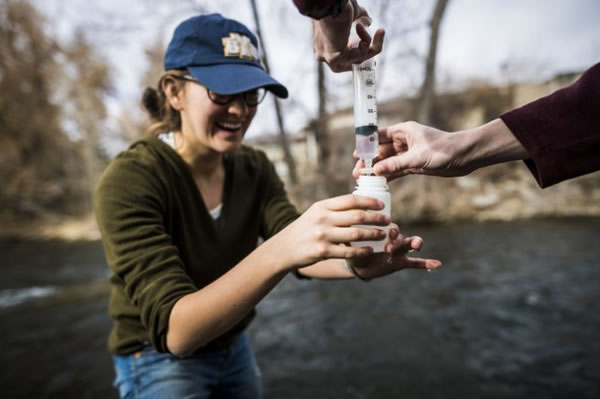News Article
March 15, 2018
Citizen Science Project to Improve Utah Lake
iUTAH researcher Erin Jones helped lead a citizen water sampling effort to study and assess rivers and streams that lead into Utah Lake. Aimed at identifying the source of pollutants, this first project involved roughly 150 participants on March 10.
Jones, a teaching assistant for the participating Watershed Ecology class at Brigham Young University, said that around two-thirds of the people involved had contributed to a scientific study before this one. Of the people she talked to, most had some connection to water resources or just a general concern about the environment in general and Utah Lake specifically.
“I think one of my favorite parts about talking with people as they came to pick up their sampling materials or return their filled bottles was to hear about their connection to the watershed,” said Jones. “Many were sampling areas that they were familiar with, but hadn't necessarily ever stopped to think about the water quality there. Other people signed up to go somewhere in the watershed they had never been before, giving them a much deeper connection to place.”
Additional information on the sampling project came from reporter Auburn Remington in a March 7 article in Brigham Young University’s The Daily Universe. “BYU professor Ben Abbott, an ecosystem ecologist and the project director, said the project is focused on sampling by rivers and streams that lead into Utah Lake because they are ‘sensors of ecosystem health. Sampling many places in the river network gives you a high-resolution image, like a computer or a phone screen. If you have more points, you can see more clearly what is going on in a system,’ Abbott said. ‘What’s neat about a river is that it’s a natural organization, and the river has created this tree-like form that extends out into the landscape, and then if we listen to the river or analyze the chemistry of the river, it can tell us what’s happening.’
Abbott said the goal of the project is to identify the non-point sources of nutrients to Utah Lake, or in other words, the nutrients flowing into the lake from things other than pipes. Non-point nutrients include things that flow through the soil, such as fertilizer or contaminated storm water. ‘The other purpose of the study is to get people connected to their watershed, so we appreciate and value what we understand and know,’ Abbott said. ‘If people spend time around Utah Lake and in the rivers flowing to Utah Lake, they’ll realize that this isn’t a trashed or destroyed ecosystem, it’s a beautiful and vibrant environment.’ “
Jones said of those who participated, it would “hopefully increase their awareness and concern about local environmental issues.” The research group hopes to have another event in summer and another class at BYU in the fall to measure seasonal changes in factors such as nutrients. She invites people interested in attending future citizen science samplings of Utah Lake to visit the Utah Lake Research Collaborative website.
Press: The Daily Universe

« Back to list of all news articles


